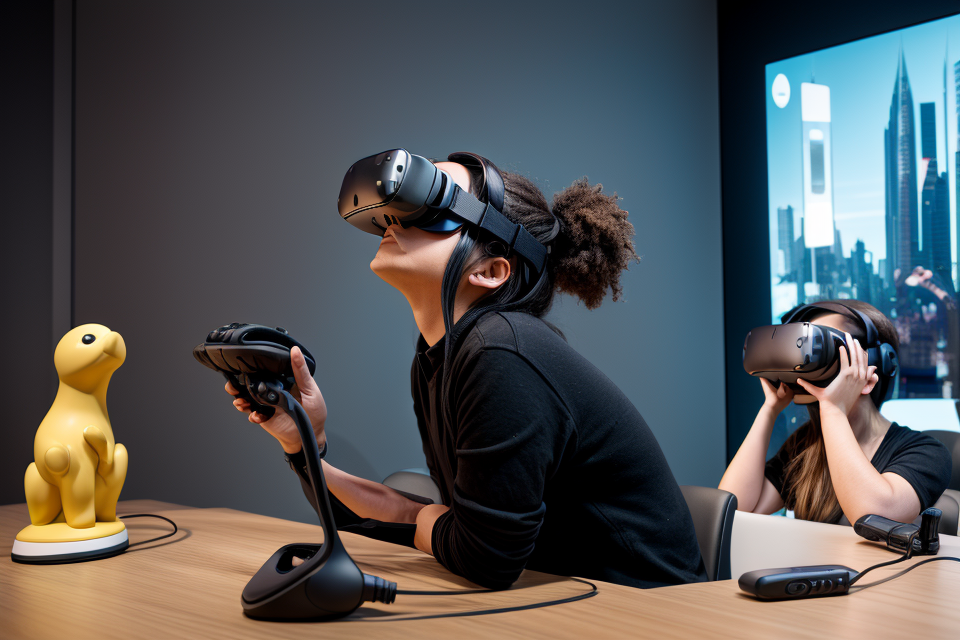
Virtual Reality (VR) and Augmented Reality (AR) are two technologies that have revolutionized the way we experience digital content. While both have their unique merits, there has been an ongoing debate about which one is more realistic. In this article, we will explore the differences between VR and AR and determine which one is more immersive and lifelike. Get ready to dive into the world of digital reality and find out which technology reigns supreme.
Understanding Virtual Reality (VR) and Augmented Reality (AR)
What is Virtual Reality?
Virtual Reality (VR) is a technology that creates immersive experiences by simulating a digital environment that users can interact with in real-time. Unlike traditional computing, which presents information on a screen, VR uses a headset or goggles to immerse the user in a virtual world. The headset typically includes sensors that track the user’s movements and a display that projects images directly into the user’s field of vision.
One of the key features of VR is its ability to create a sense of presence, or the feeling that the user is physically present in the virtual environment. This is achieved through a combination of sights, sounds, and touch. For example, in a VR game, the user might feel like they are holding a virtual gun or driving a virtual car.
VR has a wide range of applications, from gaming and entertainment to education and therapy. It is also being explored for its potential in fields such as architecture, medicine, and tourism.
Overall, VR is a powerful technology that allows users to experience digital content in a more immersive and engaging way than ever before.
What is Augmented Reality?
Augmented Reality (AR) is a technology that superimposes digital information and images onto the real world, creating an enhanced and interactive experience. It differs from Virtual Reality (VR) in that it does not create a completely immersive digital environment, but rather adds digital elements to the physical world.
Definition and explanation
AR uses a device’s camera and sensors to track the real world and overlay digital content on top of it. This technology is used in various applications, such as gaming, education, and marketing. AR allows users to interact with digital content in the real world, creating a unique and interactive experience.
How AR enhances the real world
AR enhances the real world by adding digital elements to it, creating a more immersive and interactive experience. This technology can be used to create virtual objects, characters, and environments that are superimposed onto the real world. This creates a new and exciting way for users to interact with the world around them.
AR devices and technology
There are various AR devices and technology available, such as smartphones, tablets, and smart glasses. These devices use different sensors and cameras to track the real world and overlay digital content on top of it. Some popular AR apps include Pokemon Go, IKEA Place, and Snapchat filters.
AR technology is constantly evolving and improving, making it an exciting and promising field for the future. With its ability to enhance the real world and create unique and interactive experiences, AR has the potential to revolutionize the way we interact with technology and the world around us.
Comparing Realism in VR and AR
Factors affecting realism in VR and AR
When it comes to determining the realism of virtual reality (VR) and augmented reality (AR), several factors come into play. These factors include hardware and technology, user experience and immersion, and content and quality.
Hardware and technology
The hardware and technology used in VR and AR systems play a significant role in determining their realism. For instance, VR systems typically use head-mounted displays (HMDs) or headsets to create a fully immersive experience. AR systems, on the other hand, rely on the use of smartphones or tablets to display augmented content in the real world.
The processing power and capabilities of the hardware also affect the realism of the experience. High-end VR systems with powerful processors and graphics cards can create more detailed and realistic environments, while lower-end systems may struggle to provide a seamless experience.
In AR, the quality of the camera and display on the device used to view the augmented content can also impact the realism of the experience. For example, a higher resolution camera and display can create a more detailed and realistic image of the augmented content.
User experience and immersion
The user experience and immersion in VR and AR systems also play a role in determining their realism. VR systems typically use motion tracking and haptic feedback to create a more immersive experience, while AR systems rely on the user’s ability to interact with the real world.
For example, VR systems may use hand controllers or motion sensors to track the user’s movements and provide a more natural and intuitive experience. AR systems may use touchscreens or voice commands to allow the user to interact with the augmented content.
The level of immersion in both VR and AR systems can also be impacted by the level of realism in the content itself. For example, highly realistic and detailed environments in VR can create a more immersive experience, while in AR, the realism of the augmented content can impact the user’s perception of the real world.
Content and quality
The content and quality of the experiences in VR and AR systems also play a role in determining their realism. VR systems typically offer a wider range of content, including games, simulations, and educational experiences. AR systems are typically used for more practical applications, such as navigation, training, and information overlay.
The quality of the content can also impact the realism of the experience. High-quality content with realistic graphics, sound, and motion can create a more immersive experience, while lower-quality content may be less convincing.
In conclusion, the realism of VR and AR systems is influenced by several factors, including hardware and technology, user experience and immersion, and content and quality. Understanding these factors can help users make informed decisions when choosing between VR and AR systems and can also inform the development of new systems to improve the overall experience.
VR’s advantages in realism
Virtual Reality (VR) has several advantages over Augmented Reality (AR) when it comes to creating realistic experiences. These advantages include:
Closed environment experiences
One of the main advantages of VR is that it allows users to experience completely closed environments. This means that users can fully immerse themselves in a virtual world, which can be designed to look and feel as realistic as possible. In contrast, AR is often used to enhance the user’s perception of the real world, rather than creating a completely new environment.
Advanced haptic feedback
Another advantage of VR is its ability to provide advanced haptic feedback. Haptic feedback refers to the sense of touch, and VR can simulate a wide range of sensations, from the feeling of wind on your face to the sensation of holding a virtual object. This can make VR experiences feel much more realistic and immersive. In contrast, AR typically relies on the user’s own sense of touch, which may not always be as convincing.
Increased immersion through VR headsets
Finally, VR headsets are designed to provide a fully immersive experience. They typically have high-resolution displays that create a clear and detailed image, and they may also include other features such as 3D audio and motion tracking. This can make VR experiences feel much more realistic and immersive than AR experiences, which are often viewed through a smartphone or tablet screen.
Overall, VR has several advantages over AR when it comes to creating realistic experiences. However, it is important to note that the realism of a VR or AR experience can also depend on the quality of the content and the skill of the developers. As technology continues to improve, it will be interesting to see how VR and AR continue to evolve and compete in the realm of realism.
AR’s advantages in realism
- Integration with the real world:
- Augmented reality (AR) technology seamlessly integrates digital content into the user’s real-world environment, enhancing their perception of the physical world. This integration creates a more believable and realistic experience as it does not fully detach the user from their surroundings.
- For instance, AR can superimpose digital information, such as directions or product details, onto real-world objects or locations, making the information feel more relevant and connected to the user’s immediate environment.
- Use of existing surroundings:
- AR utilizes the user’s actual surroundings as a foundation for the digital content, which adds an extra layer of realism. The digital elements are placed in context with the physical environment, making the experience feel more authentic and grounded.
- This approach also reduces the need for a dedicated, controlled space, as AR can be experienced in various environments, enhancing the versatility and accessibility of the technology.
- Accessibility and ease of use:
- AR’s accessibility and ease of use contribute to its realism. The technology can be accessed through a variety of devices, such as smartphones or smart glasses, making it more widely available and user-friendly.
- As AR technology continues to advance and become more widespread, it has the potential to be integrated into everyday objects and devices, further enhancing its realism by creating a more seamless and unobtrusive experience.
Please note that this response focuses on the advantages of AR’s realism as outlined in the provided outline. It does not discuss VR’s realism or compare the two technologies directly.
The Future of Realism in VR and AR
Advancements in VR and AR technology
Upcoming hardware and software developments
- As technology continues to advance, we can expect to see significant developments in both VR and AR hardware and software.
- For VR, there is a focus on improving resolution, reducing latency, and increasing the field of view.
- For AR, there is a focus on making the technology more seamless and unobtrusive, with a greater emphasis on creating a natural and realistic integration with the real world.
How advancements will impact realism
- The advancements in VR and AR technology will have a significant impact on the realism of the experiences they offer.
- As VR and AR systems become more advanced, they will be able to create more realistic environments, characters, and interactions.
- This will lead to a more immersive and engaging experience for users, making it harder to distinguish between the virtual and real world.
- Additionally, advancements in VR and AR technology will also enable new and innovative use cases, such as virtual training and education, remote collaboration, and more.
Potential applications and impact on industries
Gaming
Virtual reality and augmented reality technologies have the potential to revolutionize the gaming industry by providing immersive experiences that are more realistic than ever before. VR and AR can create lifelike environments that allow players to fully immerse themselves in the game world, increasing engagement and realism. This technology can be used to create new types of games that cannot be experienced in traditional gaming, such as first-person perspective games or games that simulate real-world environments.
Education
Both VR and AR technologies have the potential to transform education by providing more engaging and interactive learning experiences. In particular, AR can be used to overlay digital information onto the real world, allowing students to learn about different subjects in a more interactive and engaging way. For example, AR can be used to create interactive textbooks or to simulate experiments in science class.
Healthcare
Both VR and AR technologies have the potential to transform healthcare by providing more effective and efficient ways of training medical professionals and treating patients. VR can be used to create virtual medical environments where medical professionals can practice procedures and learn new techniques. AR can be used to overlay digital information onto the real world, allowing medical professionals to see patient data and other important information in real-time.
Training and simulation
Both VR and AR technologies have the potential to transform training and simulation across a wide range of industries. For example, VR can be used to create virtual environments for military training, allowing soldiers to practice combat scenarios in a safe and controlled environment. AR can be used to overlay digital information onto the real world, allowing workers in fields such as construction and manufacturing to see digital models and data overlaid onto the physical environment.
FAQs
1. What is the difference between VR and AR?
Virtual Reality (VR) and Augmented Reality (AR) are two different technologies that provide different immersive experiences. VR is a fully immersive experience that transports users to a virtual world, while AR enhances the real world with digital elements. VR uses headsets and controllers to create a fully immersive experience, while AR uses devices like smartphones and tablets to overlay digital elements on the real world.
2. Which one is more realistic, VR or AR?
Both VR and AR have their own strengths and weaknesses when it comes to realism. VR is often considered more realistic as it provides a fully immersive experience that completely transports users to a virtual world. On the other hand, AR is less realistic as it enhances the real world with digital elements, which can sometimes be distracting or disruptive to the user’s experience.
3. What are the advantages of VR over AR?
VR has several advantages over AR, including a more immersive experience, better graphics, and the ability to create fully-realized virtual worlds. VR also provides a more seamless experience, as users are not distracted by the real world while using VR. Additionally, VR can be used for a wider range of applications, including gaming, education, and therapy.
4. What are the advantages of AR over VR?
AR has several advantages over VR, including the ability to enhance the real world with digital elements, which can be useful for a wide range of applications, including education, training, and product visualization. AR also does not require users to wear bulky headsets or controllers, making it more accessible and convenient to use.
5. Which one is better for different applications?
Both VR and AR have their own strengths and weaknesses, and the best choice depends on the specific application. For gaming and entertainment, VR is often considered the better choice, as it provides a more immersive experience. For education, training, and product visualization, AR is often considered the better choice, as it enhances the real world with digital elements. Ultimately, the choice between VR and AR depends on the specific needs and goals of the user or organization.


